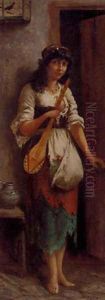Stifter Moritz Paintings
Moritz Stifter, born on October 28, 1805, in the town of Horní Planá (then known as Oberplan) in the Austrian Empire, was a Bohemian-Austrian painter, although not as widely recognized as some of his contemporaries. His works were often overshadowed by the more prominent artists of the period, and as such, there is limited information available about his life and work compared to more famous artists.
Stifter showed an inclination towards art from an early age, but his path was not straightforward. Initially, he pursued a career in education, which was a more stable and respectable choice at the time. He worked as a tutor for several years, and this experience with teaching and education informed much of his approach to art and life. Despite his early career in education, Stifter maintained his passion for art, consistently working on his craft.
Eventually, Moritz Stifter did manage to establish himself as a painter. His work was primarily in the Biedermeier style, characterized by a focus on simplicity, unpretentiousness, and a sense of bourgeois domesticity. This style was popular in the German-speaking countries and parts of Scandinavia during the first half of the 19th century, in the period between the end of the Napoleonic Wars in 1815 and the onset of the revolutions of 1848.
Stifter's oeuvre includes landscapes, portraits, and genre scenes. His landscapes, in particular, often depicted the serene beauty of the Bohemian Forest, a locale that was close to his heart and frequently featured in his works. These paintings showcased his ability to capture the tranquility of nature and the simple life of the rural populace.
Moritz Stifter's artistic output, though not as prolific or influential as some of his contemporaries, provides a window into the Biedermeier period's aesthetics and values. He passed away on November 18, 1868, in Vienna, leaving behind a modest but heartfelt body of work that continues to be appreciated by art connoisseurs and historians with an interest in the Biedermeier era.
